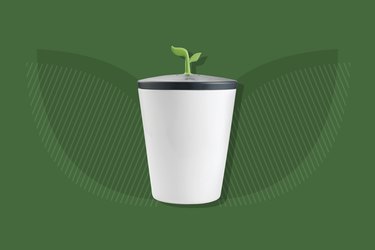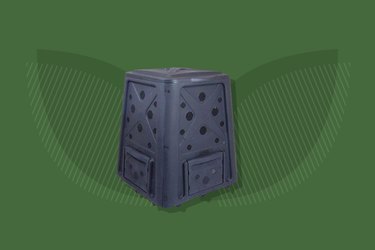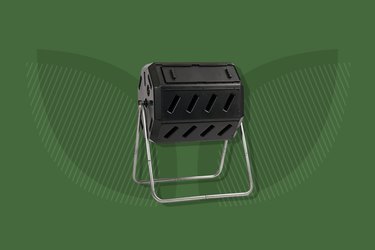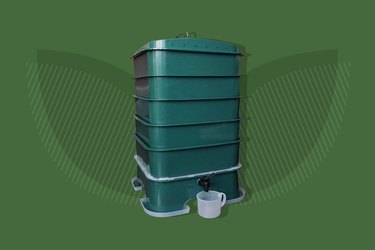
If you've wanted to compost your food and scraps for a while now, here's some good news: It's incredibly easy to get started! All you need are a few key items, and you'll be benefiting both the environment and your own backyard (or a local community garden).
Compost is organic material that can be added to soil to help it grow, per the United States Environmental Protection Agency (EPA). Nearly 30 percent of what we throw away includes food scraps and yard waste, which could be used to make compost instead. Doing so keeps that waste out of landfills, where it otherwise takes up space and releases a powerful greenhouse gas called methane.
Video of the Day
Video of the Day
What's more, when you use compost in your yard or donate it to a community garden, it can help enrich the soil and suppress plant diseases — reducing the need for chemical fertilizers. Here's exactly how to compost at home today.
5 Common Ways to Compost
There are several ways you can lower your environmental footprint through composting, whether you live in an apartment or have a yard you can compost in.
- Donate food scraps: Your first option is to simply collect food scraps in a compost pail with a tight lid and hand them off to a compost collection organization. You can visit CompostNow.org to find local compost pickup services or ShareWaste.com to find a neighbor who's composting and could use your scraps.
- Compost in a bin: To compost yourself, you can purchase or make a simple compost bin and aerate the compost pile every two to three days by turning the materials. Doing so allows air to reach the microbes that are decomposing your materials, per the Washington State University. Making your own bin can be as simple as drilling holes into a plastic container for aeration.
- Use a compost tumbler: This may be a good option if you have a spacious balcony or yard, since compost tumblers are typically too large to keep inside. Tumblers come equipped with a handle or another tool to help aerate and mix contents, and are fully sealed to preserve heat from your compost — which speeds up decomposition, per EarthEasy.
- Create a compost pile: You can simply gather compost materials in a pile in your backyard, but you still need to regularly turn or mix them to add air and speed up their breakdown, per the New York State Department of Environmental Conservation. If your pile gets too wet, add shredded newspaper, sawdust or leaves. If it's too dry, add a little water.
- Use worms to compost: While you certainly don't always need worms to compost, they can help speed up the process. "Because worms are much bigger than microbes, they can handle much more material," says Lauren Olson, Zero Waste Manager at World Centric, a company that offers compostable products. If you're interested in vermicomposting, or composting with worms, you'll need a special type of bin that allows for the right amount of oxygen and water for the worms. You can buy one or make it yourself (the EPA provides a step-by-step guide).
What You Need for Composting
There are two basic things you'll need to start composting: carbon-rich "brown" items and nitrogen-rich "green" items. Despite commonly being referred to as "brown" or "green," keep in mind that the materials may not necessarily be these colors.
Carbon-rich “brown” items include:
- Dead leaves
- Branches
- Twigs
- Dried grass
- Egg cartons made out of fiber
- Newspaper
- Sawdust
Nitrogen-rich “green” items include:
- Grass clippings
- Vegetable waste
- Fruit scraps
- Coffee grounds
- Egg shells
The C:N Ratio
Having the correct ratio will help ensure that bacteria will be able to decompose your organic material in a timely manner.
"It's kind of like tending a fire: You need to have the right ratio of items so that the microbes in there can continue to thrive," Olson says. "For the most part, you want more brown items than green items."
That's because microorganisms in compost use nitrogen for protein synthesis and carbon for energy, per the Oregon State University Extension Service.
The ratio of carbon to nitrogen, also known as the C:N ratio, will vary depending on what materials you use. The optimal C:N ratio is 25:1 to 40:1, which may equate to approximately ⅔ brown items to ⅓ green items.
Tip
You can determine your compost’s C:N ratio using this calculator.
"Brown" items also typically make your compost drier, while "green" items are usually moist.
"That's the other key because you want your compost to be a little wet, but it can't be too wet," Olson says. Compost that is too moist can cause odor issues and may not decompose properly.
The Composting Tools You Need
You have several options when it comes to the tools you use for composting — whether you live in an apartment or in a home with a backyard.
"If you're in a house, you might have residential curbside composting available, which is great," Olson says. "But a lot of places don't, so building your own bin in the backyard might be a possibility for you depending on your local ordinances. Bins can be as simple or ornate as you want to make them — or you can even just experiment with a compost pile."
If you live in an apartment, you can use something as simple as an old yogurt container with a lid to collect food scraps until you're ready to move them to a larger bin or donate them.
"You can also reach out to your local waste management hauler and see if they will give you a small compost bin for your countertop for free," Olson says.
Here are four common composting tools to try, depending on how much space you have:
1. Chef’n EcoCrock Counter Compost Bin

If you're looking for a simple container to hold your food scraps before donating them or taking them to a larger bin, this bucket is a great option. The quarter-gallon bin features a vented lid and a replaceable natural charcoal filter that traps odors.
Buy it: Amazon.com; Price: $30.50
2. Redmon Since 1883 Compost Bin

For a larger container that you can store outside, this easy-to-assemble bin has multiple holes for proper aeration and is produced from 80 percent post-consumer waste (recycled plastics).
Buy it: Amazon.com; Price: $46.57
3. FCMP Outdoor IM4000 Tumbling Composter

This impressive 37-gallon tumbling composter will help you avoid digging and mixing compost by hand. Simply close the door and turn it five to six times every two to three days: This easy-to-use tumbler is great for beginner composting!
Buy it: Amazon.com; Price: $89.99
4. VermiHut Plus 5-Tray Worm Compost Bin

If you're interested in composting with worms, this bin is designed to increase air flow, control moisture and keep fruit flies and ants away.
Buy it: Amazon.com; Price: $99.95
What You Can Compost
There are several foods and materials you can use to make compost and reduce your waste. According to the EPA, these include:
- Fruits and vegetables
- Eggshells
- Tea bags
- Coffee grounds and filters
- Nut shells
- Shredded newspaper
- Paper
- Cardboard
- Yard trimmings
- Grass clippings
- Houseplants
- Hay and straw
- Leaves
- Sawdust
- Wood chips
- Cotton and wool rags
- Hair and fur
- Dryer and vacuum cleaner lint
- Hair and fur
- Fireplace ashes
What You Can’t Compost
Some materials are best to avoid because they can release substances that might be harmful to plants, create odor problems, transfer diseases to other plants, contain bacteria or attract pests like rodents and flies, per the EPA.
These materials include:
- Dairy products like butter, milk, sour cream and yogurt
- Eggs
- Black walnut tree leaves or twigs
- Coal or charcoal ash
- Diseased or insect-ridden plants
- Fats, grease, lard or oils
- Meat or fish bones and scraps
- Pet wastes like feces or soiled cat litter
- Yard trimmings treated with chemical pesticides
Tip
That said, your local curbside or drop-off composting program may accept some of these materials, so call ahead if you have any questions about what you can hand off.
How to Prevent Bad Odors When Composting
Tending to your compost properly by making sure the moisture and mix of brown to green materials is just right is the best way to avoid odors.
"If you have your compost pile or system well-managed and not too wet, you will have no odors," says Olson. "It's when things get out of balance — particularly when you have too many 'green' items — or it's not being turned or aerated that you might get some odors."
There are easy solutions for common causes of smelly compost, per the EPA:
- There are too many "greens:" Add more "browns" and turn your pile of compost.
- There isn't enough air: Turn your pile of compost.
- There is too much water: Add dry "browns" and turn the pile.
How to Tell if Compost Is Ready
Texture will be your biggest clue when it comes to compost readiness.
"You'll see most of the material has disintegrated so it's really small, and it also turns a really rich, dark color," says Olson. "If it has the right amount of moisture level, it should clump up a little bit but not be as clumpy as clay."
Your compost should also smell earthy, per the New York State Department of Environmental Conservation. Once your compost is ready, you can use it in several ways:
- Mix your compost into garden soil or sprinkle it on your lawn, which will improve soil texture and moisture, and also add beneficial microorganisms and nutrients (screen compost with ½ inch mesh or smaller before adding it to lawn).
- Use your compost as a mulch around garden beds, trees or shrubs.
- Replace ½ to ⅓ of your soil for houseplants with the compost.
If you have extra compost, you may be able to donate it to a community garden, says Olson.
On the other hand, if nothing is happening to your compost piles, there may be three reasons why, per the New York State Department of Environmental Conservation:
- Your compost pile is too small: Add more material to increase its size.
- It's too wet or not getting enough air: Add more "browns" and turn the pile. Only a few drops of water should come out of your composting material when you squeeze a handful of it.
- There are too many browns. Mix in more "greens."
How long it takes for your compost to be ready will vary widely depending on the process and materials you use, plus how you manage the system. It takes three to six months for a worm bin to turn food scraps into compost, and an unmanaged leaf pile may take more than a year, per the Cornell Waste Management Institute.
Related Reading
The Environmental Benefits of Composting
Composting enriches your soil, but it also lowers the need for chemical fertilizers and reduces methane emissions from landfills — lowering your carbon footprint, per the EPA.
"Methane is a very potent greenhouse gas in terms of causing global warming and climate change," says Olson.
In fact, in the first two decades after its release, methane is 84 times more potent than carbon dioxide and is initially far more damaging to the climate because of how it absorbs heat, according to the Environmental Defense Fund.
Composting also saves water by helping the soil to better hold moisture (which reduces water runoff) and cuts down on the need for commercial soil conditioners and fertilizers, per the University of California Division of Agriculture and Natural Resources.
- United States Environmental Protection Agency: "Composting At Home"
- Washington State University Whatcom County Extension: "Compost Fundamentals"
- The Spruce: "How to Make a Compost Bin Using a Plastic Storage Container"
- EarthEasy: "How to Compost in an Apartment"
- New York State Department of Environmental Conservation: "Home Composting"
- United States Environmental Protection Agency: "How to Create and Maintain an Indoor Worm Composting Bin"
- Oregon State University Extension Service: "Master Composting Program"
- Morning Chores: " Carbon to Nitrogen Compost Calculator: Create the Perfect Compost Pile"
- Cornell Waste Management Institute: "Cornell Composting"
- Environmental Defense Fund: "Methane: The other important greenhouse gas"
- University of California Division of Agriculture and Natural Resources: "University of California Division of Agriculture and Natural Resources"